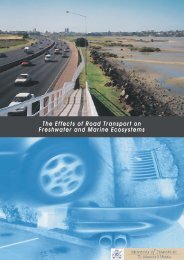Download a historical timeline of road safety in New Zealand
Download a historical timeline of road safety in New Zealand
Download a historical timeline of road safety in New Zealand
You also want an ePaper? Increase the reach of your titles
YUMPU automatically turns print PDFs into web optimized ePapers that Google loves.
Road Safety Progress<br />
In 1973, <strong>New</strong> <strong>Zealand</strong> suffered its highest ever <strong>road</strong> toll, 843 deaths <strong>in</strong> a<br />
s<strong>in</strong>gle year. Our population at this time was just over 3 million and there were<br />
less than half the number <strong>of</strong> cars we now have on the <strong>road</strong>.<br />
The <strong>in</strong>ternational energy crisis and subsequent <strong>in</strong>troduction <strong>of</strong> carless days<br />
and a lower open <strong>road</strong> speed limit helped with a drop <strong>in</strong> the <strong>road</strong> toll <strong>in</strong> the<br />
years immediately follow<strong>in</strong>g 1973’s tragic result. Over the next 35 years<br />
significant changes were made that have helped ensure such a horrific toll<br />
has not been repeated despite a rise <strong>in</strong> population and vehicle numbers.<br />
Changes over this time have <strong>in</strong>cluded lower alcohol limits, the use <strong>of</strong> hard<br />
hitt<strong>in</strong>g public awareness campaigns, targeted enforcement through measures<br />
such as compulsory breath test<strong>in</strong>g, speed cameras and the <strong>in</strong>troduction <strong>of</strong> the<br />
graduated driver licens<strong>in</strong>g system, the first <strong>of</strong> its k<strong>in</strong>d <strong>in</strong> the world. Vehicle<br />
<strong>safety</strong> improvements have also helped reduce the impact <strong>of</strong> crashes.<br />
In the 2000s progress began to slow and it became clear that the focus on the<br />
Three Es <strong>of</strong> ‘Enforcement, Eng<strong>in</strong>eer<strong>in</strong>g and Education that had dom<strong>in</strong>ated<br />
<strong>New</strong> <strong>Zealand</strong>’s <strong>road</strong> <strong>safety</strong> approach would not be enough to br<strong>in</strong>g about<br />
further significant decreases.<br />
In 2010, follow<strong>in</strong>g substantial public engagement, the government launched<br />
Safer Journeys: <strong>New</strong> <strong>Zealand</strong>’s Road Safety Strategy 2010-2020. The<br />
strategy <strong>in</strong>troduced a Safe System approach to <strong>New</strong> <strong>Zealand</strong>’s <strong>road</strong> <strong>safety</strong><br />
effort, tak<strong>in</strong>g a b<strong>road</strong>er focus and sett<strong>in</strong>g actions for safe <strong>road</strong>s, safe speeds,<br />
safe vehicles and safe <strong>road</strong> use.<br />
Already a number <strong>of</strong> significant actions have been taken as a result <strong>of</strong> Safer<br />
Journeys.<br />
If we had the same rate <strong>of</strong> <strong>road</strong> death as we did <strong>in</strong> 1973, given the number <strong>of</strong><br />
cars now, there would be about 1900 <strong>road</strong> deaths this year. The 2011 <strong>road</strong> toll<br />
is likely to be a much more encourag<strong>in</strong>g result but even so there is still a lot <strong>of</strong><br />
work to do. The government will cont<strong>in</strong>ue to progress Safer Journeys, and we<br />
can all play a part. Whether we are <strong>road</strong> designer or <strong>road</strong> user, a vehicle<br />
retailer or a vehicle owner there are steps we can take to improve <strong>safety</strong> on<br />
our <strong>road</strong>s and to keep the <strong>road</strong> toll down.<br />
Page 1 <strong>of</strong> 5
Timel<strong>in</strong>e <strong>of</strong> Road <strong>safety</strong> <strong>in</strong> <strong>New</strong> <strong>Zealand</strong><br />
1905 <strong>New</strong> <strong>Zealand</strong>’s first known motor vehicle death occurs <strong>in</strong> Duned<strong>in</strong>. A<br />
young motorcyclist dies after a collision with a tra<strong>in</strong> at a level cross<strong>in</strong>g.<br />
1925 Driver licences become compulsory for all drivers.<br />
1929 Our first <strong>of</strong>ficial roll toll is announced – 69 deaths. Before the <strong>of</strong>ficial<br />
count began, <strong>road</strong> deaths were reported through radio and newspaper<br />
reports. From 1908 to 1929 there were an estimated 300 <strong>road</strong> deaths.<br />
1930 By this time, both Well<strong>in</strong>gton and Duned<strong>in</strong> have <strong>in</strong>stalled traffic lights at<br />
problem <strong>in</strong>tersections. The system proves so successful that it is<br />
adopted as the national standard.<br />
1937 The first edition <strong>of</strong> the <strong>road</strong> code is sent to every <strong>New</strong> <strong>Zealand</strong><br />
household<br />
The first national <strong>road</strong> <strong>safety</strong> campaign appears.<br />
Compulsory Warrant <strong>of</strong> Fitness checks are <strong>in</strong>troduced.<br />
Police beg<strong>in</strong> report<strong>in</strong>g <strong>in</strong>jury crashes to the Transport Department.<br />
Previously, only fatal statistics were kept.<br />
Traffic <strong>in</strong>spectors appo<strong>in</strong>ted to enforce traffic laws.<br />
1950 The first Stop signs are used at <strong>in</strong>tersections.<br />
1956 Motorcyclists travell<strong>in</strong>g at over 30mph (50km/h) now have to wear a<br />
helmet.<br />
1957 Give Way signs appear.<br />
1961 The Department <strong>of</strong> Transport launches its first TV <strong>road</strong> <strong>safety</strong><br />
campaign.<br />
1965 All new cars and light trucks are required to be fitted with <strong>safety</strong> belts.<br />
1967 The demerit po<strong>in</strong>ts system is <strong>in</strong>troduced.<br />
1968 Road crash data is computerised for the first time<br />
1969 The first ‘breathalyser’ is <strong>in</strong>troduced to test drivers’ alcohol levels. The<br />
legal limit was set at 100mg per 100ml <strong>of</strong> blood. In its<br />
first year <strong>of</strong> operation 2,928 drivers are tested with the breathalyser.<br />
Only 214 are sober enough to drive!<br />
Page 2 <strong>of</strong> 5
1973 Helmets are made compulsory for all motorcyclists and their<br />
passengers.<br />
<strong>New</strong> <strong>Zealand</strong> suffers its highest ever <strong>road</strong> toll, 843 deaths <strong>in</strong> a s<strong>in</strong>gle<br />
year. Our population at this time was just over 3 million.<br />
1978 The legal blood alcohol limit is lowered from 100 milligrams <strong>of</strong> alcohol<br />
per 100 millilitres <strong>of</strong> blood to 80 milligrams per 100 millilitres.<br />
Evidential breath test<strong>in</strong>g is <strong>in</strong>troduced.<br />
1979 <strong>New</strong> <strong>Zealand</strong> <strong>in</strong>troduces carless days <strong>in</strong> response to the <strong>in</strong>ternational<br />
oil crisis. There is a subsequent, massive drop <strong>in</strong> <strong>road</strong> fatalities.<br />
It becomes compulsory for children over the age <strong>of</strong> eight to wear a<br />
<strong>safety</strong> belt.<br />
1983 Legislation is <strong>in</strong>troduced that allows Courts to require repeat dr<strong>in</strong>k or<br />
drugged drivers to attend an Assessment Centre, and to be disqualified<br />
from hold<strong>in</strong>g or obta<strong>in</strong><strong>in</strong>g a licence.<br />
1984 The Accident Investigation System is <strong>in</strong>troduced. This allowed more<br />
detailed analysis <strong>of</strong> crash data.<br />
1987 <strong>New</strong> <strong>Zealand</strong> becomes the first country <strong>in</strong> the world to <strong>in</strong>troduce a<br />
Graduated Driver Licens<strong>in</strong>g System <strong>in</strong>troduced, creat<strong>in</strong>g a staged<br />
process for ga<strong>in</strong><strong>in</strong>g a full licence.<br />
Hawk radars are <strong>in</strong>troduced to catch speed<strong>in</strong>g drivers. These can be<br />
used from mov<strong>in</strong>g patrol cars as well as stationary at the <strong>road</strong>side.<br />
1992 The Traffic Safety Service is merged with Police.<br />
1993 Compulsory breath test<strong>in</strong>g is <strong>in</strong>troduced, allow<strong>in</strong>g the police to breath<br />
test any driver for alcohol, anywhere, at any time.<br />
Dr<strong>in</strong>k drive limits are reduced for under 20 year olds.<br />
Speed cameras are put <strong>in</strong>to use.<br />
1994 Cycle helmets are made compulsory.<br />
Child restra<strong>in</strong>ts are made compulsory for 0-2 year olds.<br />
1995 Child restra<strong>in</strong>ts are made compulsory for 3-5 year olds.<br />
The National Road Safety Plan is launched. Us<strong>in</strong>g hard-hitt<strong>in</strong>g, high<br />
pr<strong>of</strong>ile advertis<strong>in</strong>g and <strong>in</strong>creased enforcement, it aims to reduce the<br />
<strong>road</strong> toll to 402 or less by the year 2001.<br />
Page 3 <strong>of</strong> 5
1996 <strong>New</strong> <strong>Zealand</strong>’s annual <strong>road</strong> toll is 515, the lowest number <strong>in</strong> 32 years.<br />
<strong>New</strong> advertisements feature the slogan ‘If you dr<strong>in</strong>k and drive, you’re a<br />
bloody idiot.’<br />
1997 Hidden speed cameras are trialled <strong>in</strong> several locations.<br />
1998 The Crash Analysis System or CAS is launched. CAS holds<br />
<strong>in</strong>formation on crashes and maps their location.<br />
1999 Vehicle impoundment for disqualified drivers <strong>in</strong>troduced.<br />
Road sided suspension <strong>in</strong>troduced for a number <strong>of</strong> <strong>of</strong>fences <strong>in</strong>clud<strong>in</strong>g<br />
driv<strong>in</strong>g at double the legal blood alcohol limit.<br />
2002 Legislation is passed which requires all imported passenger cars to<br />
conform to an agreed, overseas frontal impact standard.<br />
2003 Offences are created for street rac<strong>in</strong>g, wheel sp<strong>in</strong>n<strong>in</strong>g and pour<strong>in</strong>g<br />
slippery substances on the <strong>road</strong> to allow wheel sp<strong>in</strong>n<strong>in</strong>g. Further<br />
change will be made <strong>in</strong> 2009 to help crack down on these <strong>of</strong>fences.<br />
The government launches the Road Safety to 2010 strategy, which<br />
aims to reduce the <strong>road</strong> toll to no more than 300 deaths by 2010.<br />
2008 <strong>New</strong> <strong>Zealand</strong>’s annual <strong>road</strong> toll is 366. The lowest annual total s<strong>in</strong>ce<br />
1959.<br />
2009 The use <strong>of</strong> hand held mobile phones and text<strong>in</strong>g while driv<strong>in</strong>g is<br />
banned.<br />
It becomes compulsory for motorcycle and moped riders to switch on<br />
their headlamps dur<strong>in</strong>g daylight hours (unless the vehicle was<br />
manufactured before 1 January 1980).<br />
A law is <strong>in</strong>troduced that allows police to conduct a <strong>road</strong>side impairment<br />
test for drugged drivers.<br />
A law is <strong>in</strong>troduced that gives Police stronger powers to tackle illegal<br />
street rac<strong>in</strong>g and allows <strong>road</strong> controll<strong>in</strong>g authorities to make bylaws<br />
prohibit<strong>in</strong>g “cruis<strong>in</strong>g”.<br />
2010 The government launches Safer Journeys: <strong>New</strong> <strong>Zealand</strong>’s Road Safety<br />
Strategy 2010-2020 follow<strong>in</strong>g substantial public engagement on <strong>road</strong><br />
<strong>safety</strong> issues. The strategy <strong>in</strong>troduces a Safe System approach to <strong>New</strong><br />
<strong>Zealand</strong>’s <strong>road</strong> <strong>safety</strong> effort, mov<strong>in</strong>g beyond an earlier focus on drivers<br />
to set actions for safe <strong>road</strong>s, safe speeds, safe vehicles and safe <strong>road</strong><br />
use.<br />
Page 4 <strong>of</strong> 5
2011 A number <strong>of</strong> major changes are made as part <strong>of</strong> the implementation <strong>of</strong><br />
the Safer Journeys strategy:<br />
The driv<strong>in</strong>g age is raised from 15 to 16.<br />
A zero alcohol limit is <strong>in</strong>troduced for young drivers and repeat dr<strong>in</strong>k<br />
drivers.<br />
Legislative changes are made to allow for <strong>in</strong>troduction <strong>of</strong> alcohol<br />
<strong>in</strong>terlocks.<br />
Planned changes are confirmed for give way rules at <strong>in</strong>tersections.<br />
These will come <strong>in</strong>to force <strong>in</strong> 2012.<br />
Changes are <strong>in</strong>troduced for motorcycle and moped riders, <strong>in</strong>clud<strong>in</strong>g the<br />
<strong>in</strong>troduction <strong>of</strong> a power to weight restriction on bikes for novices and a<br />
competency based tra<strong>in</strong><strong>in</strong>g and assessment option for novices. Both<br />
measures will be implemented <strong>in</strong> 2012.<br />
Page 5 <strong>of</strong> 5
















